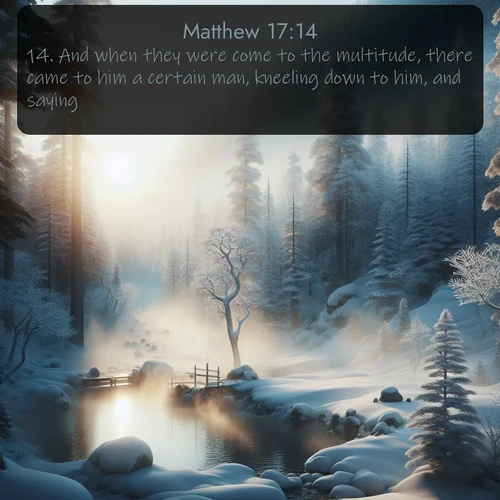Gospel of Matthew 17:14 plusieurs versions / traductions
English Bible Translations
14. And when they were come to the multitude, there came to him a certain man, kneeling down to him, and saying,
14. And when they were come to the multitude, there came to him a man, kneeling to him, saying,
14. And when they came to the people, a man went down on his knees to him, saying,
14. And when they came to the crowd, a man came to him, falling on his knees before him, and saying,
14. And when they had come to the multitude, there came to him a certain man kneeling down to him, and saying,
14. And when they came unto the multitude, there came to him a man, kneeling down to him,
German Bible Translations
14. Und da sie zu dem Volk kamen, trat zu ihm ein Mensch und fiel ihm zu Füßen
14. Und als sie zum Volke kamen, trat ein Mensch zu ihm, fiel vor ihm auf die Knie
French Bible Translations
14. Lorsqu'ils furent arrivés près de la foule, un homme vint se jeter à genoux devant Jésus et dit:
14. Lorsqu’ils furent arrivés près de la foule, un homme vint se jeter à genoux devant Jésus, et dit:
14. Lorsqu'ils furent arrivés près de la foule, un homme vint se jeter à genoux devant Jésus, et dit:
14. Et quand ils furent venus auprès de la foule, un homme s'approcha de lui, se jetant à genoux devant lui, et disant:
14. Et quand ils furent venus vers les troupes, un homme s'approcha, et se mit à genoux devant lui,
14. Et lorsqu'ils furent venus vers le peuple, il vint à lui un homme, qui se jeta à genoux devant lui, et dit:
Versions with Strong Codes
Matthew 17 / KJV_Strong14. And[G2532] when they[G846] were come[G2064] to[G4314] the[G3588] multitude,[G3793] there came[G4334] to him[G846] a certain man,[G444] kneeling down[G1120] to him,[G846] and[G2532] saying,[G3004]
Strong Code definitions
G2532 kai/kahee apparently, a primary particle, having a copulative and sometimes also a cumulative force; and, also, even, so then, too, etc.; often used in connection (or composition) with other particles or small words:--and, also, both, but, even, for, if, or, so, that, then, therefore, when, yet.
G846 autos/ow-tos' from the particle au (perhaps akin to the base of G109 through the idea of a baffling wind) (backward); the reflexive pronoun self, used (alone or in the comparative 1438) of the third person , and (with the proper personal pronoun) of the other persons:--her, it(-self), one, the other, (mine) own, said, (self-), the) same, ((him-, my-, thy- )self, (your-)selves, she, that, their(-s), them(-selves), there(-at, - by, -in, -into, of, -on, -with), they, (these) things, this (man), those, together, very, which. Compare 848. see G109 see G1438 see G848
G2064 erchomai/er'-khom-ahee middle voice of a primary verb (used only in the present and imperfect tenses, the others being supplied by a kindred (middle voice) eleuthomai el-yoo'-thomahee, or (active) eltho el'-tho, which do not otherwise occur) to come or go (in a great variety of applications, literally and figuratively):-- accompany, appear, bring, come, enter, fall out, go, grow, X light, X next, pass, resort, be set.
G4314 pros/pros a strengthened form of G4253; a preposition of direction; forward to, i.e. toward (with the genitive case, the side of, i.e. pertaining to; with the dative case, by the side of, i.e. near to; usually with the accusative case, the place, time, occasion, or respect, which is the destination of the relation, i.e. whither or for which it is predicated):-about, according to , against, among, at, because of, before, between, (where-)by, for, X at thy house, in, for intent, nigh unto, of, which pertain to, that, to (the end that), X together, to (you) -ward, unto, with(-in). In the comparative case, it denotes essentially the same applications, namely, motion towards, accession to, or nearness at. see G4253
G3588 ho/ho, including the feminine to to in all their inflections; the definite article; the (sometimes to be supplied, at others omitted, in English idiom):--the, this, that, one, he, she, it, etc.
G3793 ochlos/okh'los from a derivative of G2192 (meaning a vehicle); a throng (as borne along); by implication, the rabble; by extension, a class of people; figuratively, a riot:--company, multitude, number (of people), people, press. see G2192
G4334 proserchomai/pros-er'-khom-ahee from G4314 and 2064 (including its alternate); to approach, i.e. (literally) come near, visit, or (figuratively) worship, assent to:--(as soon as he) come (unto), come thereunto, consent, draw near, go (near, to, unto). see G4314 see G2064
G846 autos/ow-tos' from the particle au (perhaps akin to the base of G109 through the idea of a baffling wind) (backward); the reflexive pronoun self, used (alone or in the comparative 1438) of the third person , and (with the proper personal pronoun) of the other persons:--her, it(-self), one, the other, (mine) own, said, (self-), the) same, ((him-, my-, thy- )self, (your-)selves, she, that, their(-s), them(-selves), there(-at, - by, -in, -into, of, -on, -with), they, (these) things, this (man), those, together, very, which. Compare 848. see G109 see G1438 see G848
G444 anthropos/anth'-ro-pos from G435 and ops (the countenance; from G3700); man-faced, i.e. a human being:--certain, man. see G435 see G3700
G1120 gonupeteo/gon-oo-pet-eh'-o from a compound of G1119 and the alternate of G4098; to fall on the knee:--bow the knee, kneel down. see G1119 see G4098
G846 autos/ow-tos' from the particle au (perhaps akin to the base of G109 through the idea of a baffling wind) (backward); the reflexive pronoun self, used (alone or in the comparative 1438) of the third person , and (with the proper personal pronoun) of the other persons:--her, it(-self), one, the other, (mine) own, said, (self-), the) same, ((him-, my-, thy- )self, (your-)selves, she, that, their(-s), them(-selves), there(-at, - by, -in, -into, of, -on, -with), they, (these) things, this (man), those, together, very, which. Compare 848. see G109 see G1438 see G848
G2532 kai/kahee apparently, a primary particle, having a copulative and sometimes also a cumulative force; and, also, even, so then, too, etc.; often used in connection (or composition) with other particles or small words:--and, also, both, but, even, for, if, or, so, that, then, therefore, when, yet.
G3004 lego/leg'-o a primary verb; properly, to "lay" forth, i.e. (figuratively) relate (in words (usually of systematic or set discourse; whereas G2036 and 5346 generally refer to an individual expression or speech respectively; while 4483 is properly to break silence merely, and 2980 means an extended or random harangue)); by implication, to mean:--ask, bid, boast, call, describe, give out, name, put forth, say(-ing, on), shew, speak, tell, utter. see G2036 see G5346 see G4483 see G2980
Prédications qui analysent les thèmes Évangile selon Matthieu 17
Thèmes : Transfiguration de Jésus; Guérison d'un garçon démoniaque; Paiement du tribut au templeRelated Sermons discussing Gospel of Matthew 17
Themes : Transfiguration de Jésus; Guérison d'un garçon démoniaque; Paiement du tribut au templesee also: Bible Key Verses ; KJV Bible Images, BBE Bible images

